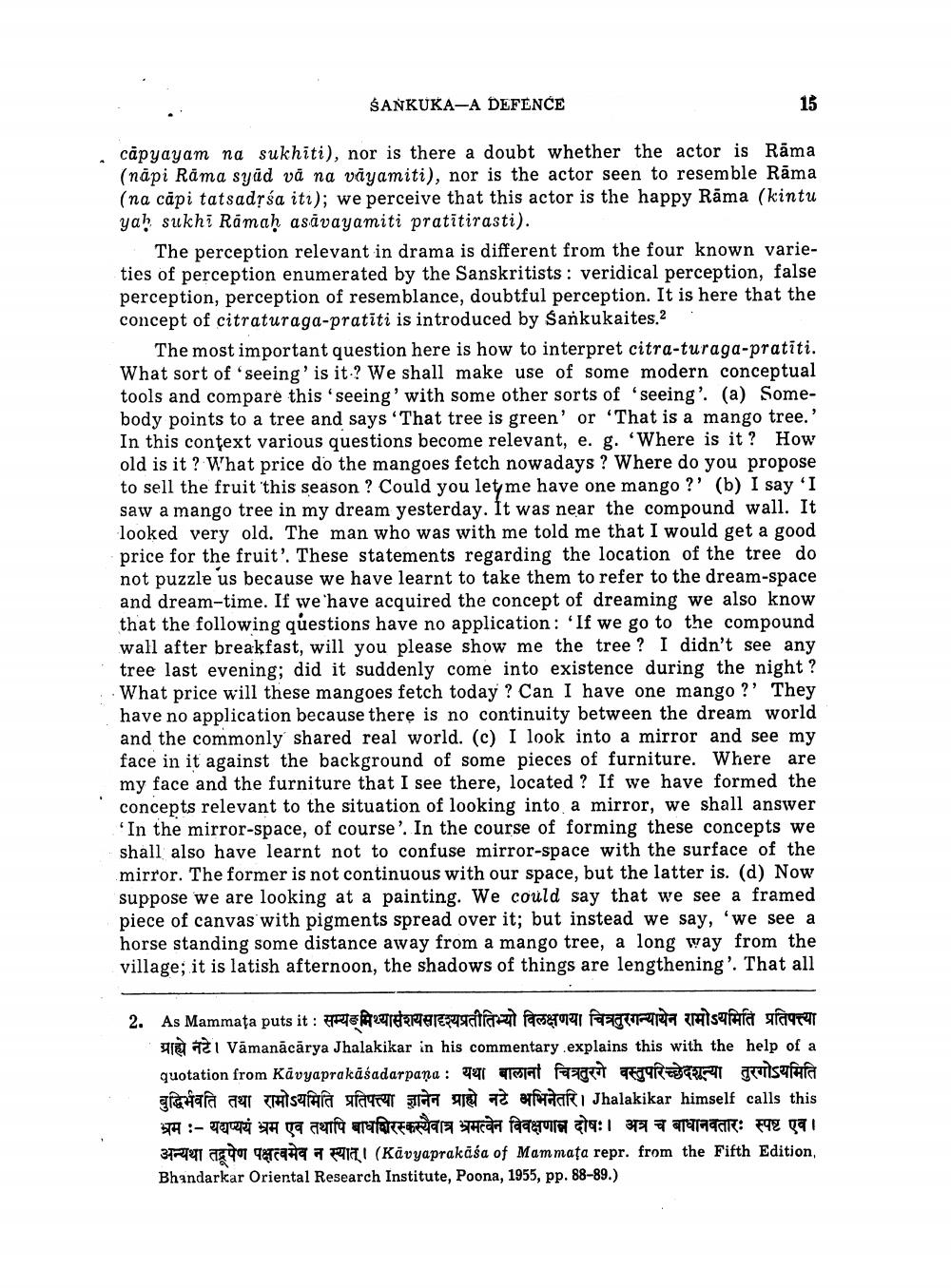________________
SANKUKA-A DEFENCE
15
capyayam na sukhiti), nor is there a doubt whether the actor is Rāma (napi Rama syad va na vāyamiti), nor is the actor seen to resemble Rāma (na cäpi tatsaděsa iti); we perceive that this actor is the happy Rāma (kintu yah sukhi Ramah asavayamiti pratitirasti).
The perception relevant in drama is different from the four known varieties of perception enumerated by the Sanskritists: veridical perception, false perception, perception of resemblance, doubtful perception. It is here that the concept of citraturaga-pratiti is introduced by Sankukaites.2
The most important question here is how to interpret citra-turaga-pratiti. What sort of seeing' is it? We shall make use of some modern conceptual tools and compare this 'seeing' with some other sorts of 'seeing'. (a) Somebody points to a tree and says 'That tree is green' or "That is a mango tree.' In this context various questions become relevant, e. g. "Where is it? How old is it? What price do the mangoes fetch nowadays? Where do you propose to sell the fruit this season ? Could you let me have one mango ?' (b) I say 'I saw a mango tree in my dream yesterday. It was near the compound wall. It looked very old. The man who was with me told me that I would get a good price for the fruit'. These statements regarding the location of the tree do not puzzle 'us because we have learnt to take them to refer to the dream-space and dream-time. If we have acquired the concept of dreaming we also know that the following questions have no application : 'If we go to the compound wall after breakfast, will you please show me the tree? I didn't see any tree last evening; did it suddenly come into existence during the night? What price will these mangoes fetch today? Can I have one mango ?' They have no application because there is no continuity between the dream world and the commonly shared real world. (c) I look into a mirror and see my face in it against the background of some pieces of furniture. Where are my face and the furniture that I see there, located ? If we have formed the concepts relevant to the situation of looking into a mirror, we shall answer 'In the mirror-space, of course'. In the course of forming these concepts we shall also have learnt not to confuse mirror-space with the surface of the mirror. The former is not continuous with our space, but the latter is. (d) Now suppose we are looking at a painting. We could say that we see a framed piece of canvas with pigments spread over it; but instead we say, 'we see a horse standing some distance away from a mango tree, a long way from the village; it is latish afternoon, the shadows of things are lengthening'. That all
2. As Mammata puts it : TRIERTERRAE caz fase og fara rastafa sfatat
21 Vāmanācārya Jhalakikar in his commentary explains this with the help of a quotation from Kavyaprakāsadarpana : यथा बालानां चित्रतुरगे वस्तुपरिच्छेदशून्या तुरगोऽयमिति alghara au THISUfara afacer SA TE T erforaaf 1 Jhalakikar himself calls this भ्रम :- यद्यप्ययं भ्रम एव तथापि बाधचिरस्कस्यैवात्र भ्रमत्वेन विवक्षणान दोषः। अत्र च बाधानवतारः स्पष्ट एव । 3Tale as cara a PTI (Kavyaprakāśa of Mammața repr. from the Fifth Edition, Bhandarkar Oriental Research Institute, Poona, 1955, pp. 88-89.)




